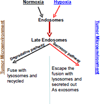The biological significance and clinical applications of exosomes in ovarian cancer
- PMID: 27058839
- PMCID: PMC4917458
- DOI: 10.1016/j.ygyno.2016.03.036
The biological significance and clinical applications of exosomes in ovarian cancer
Abstract
Exosomes are nano-sized (20-100nm) vesicles released by a variety of cells and are generated within the endosomal system or at the plasma membrane. There is emerging evidence that exosomes play a key role in intercellular communication in ovarian and other cancers. The protein and microRNA content of exosomes has been implicated in various intracellular processes that mediate oncogenesis, tumor spread, and drug resistance. Exosomes may prime distant tissue sites for reception of future metastases and their release can be mediated by the tumor microenvironment (e.g., hypoxia). Ovarian cancer-derived exosomes have unique features that could be leveraged for use as biomarkers to facilitate improved detection and treatment of the disease. Further, exosomes have the potential to serve as targets and/or drug delivery vehicles in the treatment of ovarian cancer. In this review we discuss the biological and clinical significance of exosomes relevant to the progression, detection, and treatment of ovarian cancer.
Keywords: Bio-marker; Exosomes; Hypoxia; Ovarian cancer; micro RNA.
Copyright © 2016 Elsevier Inc. All rights reserved.
Conflict of interest statement
Figures


References
-
- Nickel W. Unconventional secretory routes: direct protein export across the plasma membrane of mammalian cells. Traffic. 2005;6:607–614. - PubMed
-
- Giuntoli RL, 2nd, Webb TJ, Zoso A, Rogers O, Diaz-Montes TP, Bristow RE, et al. Ovarian cancer-associated ascites demonstrates altered immune environment: implications for antitumor immunity. Anticancer research. 2009;29:2875–2884. - PubMed
-
- Runz S, Keller S, Rupp C, Stoeck A, Issa Y, Koensgen D, et al. Malignant ascites-derived exosomes of ovarian carcinoma patients contain CD24 and EpCAM. Gynecologic oncology. 2007;107:563–571. - PubMed
-
- Dutta S, Warshall C, Bandyopadhyay C, Dutta D, Chandran B. Interactions between exosomes from breast cancer cells and primary mammary epithelial cells leads to generation of reactive oxygen species which induce DNA damage response, stabilization of p53 and autophagy in epithelial cells. PloS one. 2014;9:e97580. - PMC - PubMed
Publication types
MeSH terms
Substances
Grants and funding
LinkOut - more resources
Full Text Sources
Other Literature Sources
Medical

